|
|
The Eternal Beauty of the Goddesses
|
This kore is a masterpiece and an absolute rarity. In the 2nd half of the 6th century B.C. her elegant figure with her smiling, archaic face adorned an important Etruscan building. Her magical energy should prevent evil, her magic still enchants the viewer today. We have never had such a magnificent antefix in this completness in our program before – it makes us all the more proud to be able to present the Etruscan antefix of a kore as the highlight in this newsletter.
FOCUS ON EGYPT. Another goddess of extraordinary shape and grace originates from Egypt. The seated Isis is a rare composite sculpture, worked out in wood, gilded and decorated with bronze elements. She heralds this month's focus on Egypt. The marvelous bronze sarcophagus of a falcon and the important shabti of the priest Nesi-per-Nub from the famous cache of Bab-el-Gasus complement it. Enjoy this newsletter!
|
|
Die ewige Schönheit der Göttinnen
|
Diese Kore ist ein Meisterwerk und eine absolute Rarität. In der 2. Hälfte des 6. Jahrhunderts vor Christus schmückte ihre elegante Gestalt mit dem lächelnden, archaischen Gesicht ein bedeutendes etruskisches Gebäude. Ihre magische Kraft sollte das Böse abwehren, ihre Magie verzaubert den Betrachter noch heute. Ein derart prachtvolles Antefix in dieser Vollständigkeit hatten wir bisher noch nie im Programm - umso mehr macht es uns stolz, das etruskische Antefix einer Kore als Highlight in diesem Newsletter präsentieren zu dürfen.
|
|
|
|
Our Highlight of the Month:
|
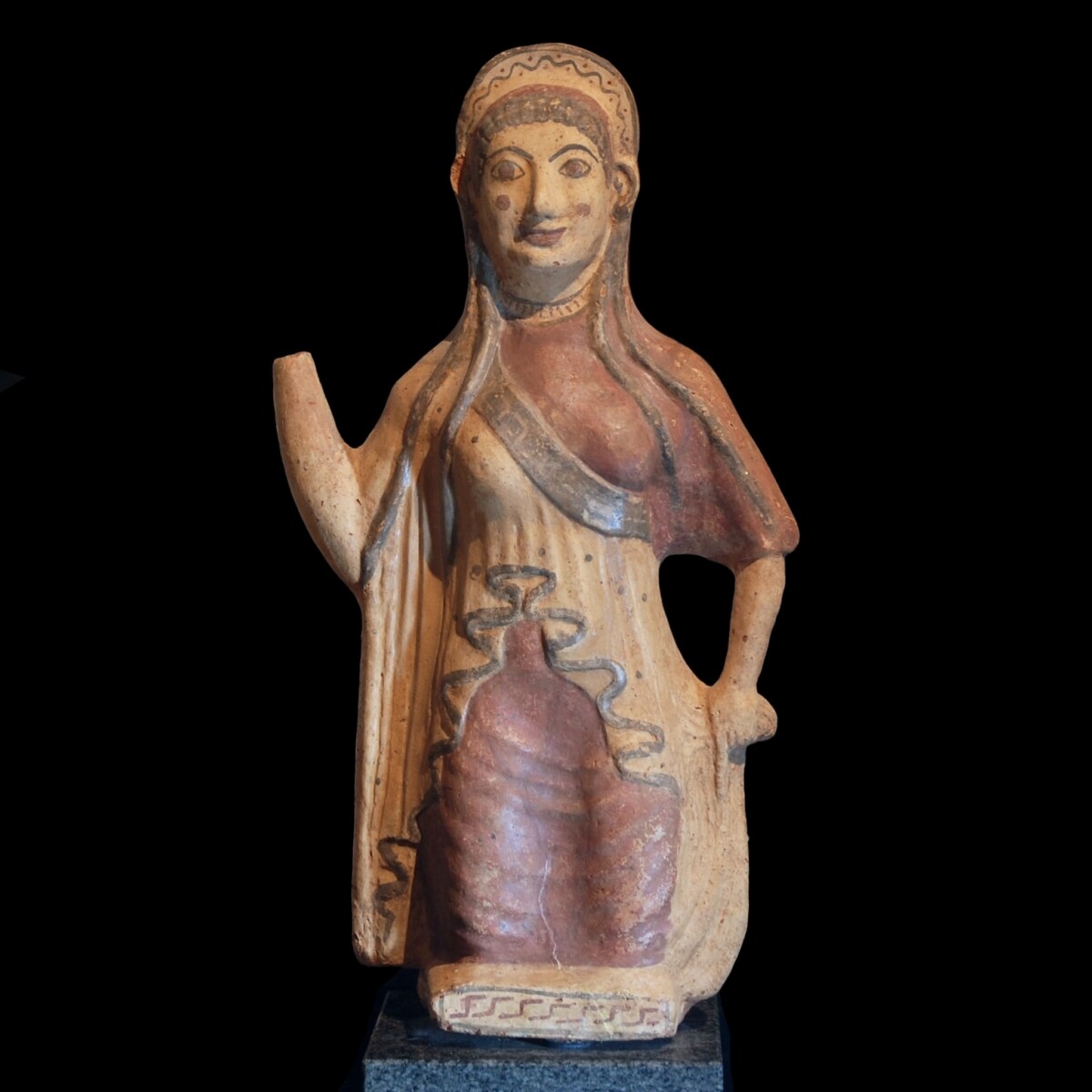
|
|
|
|
|
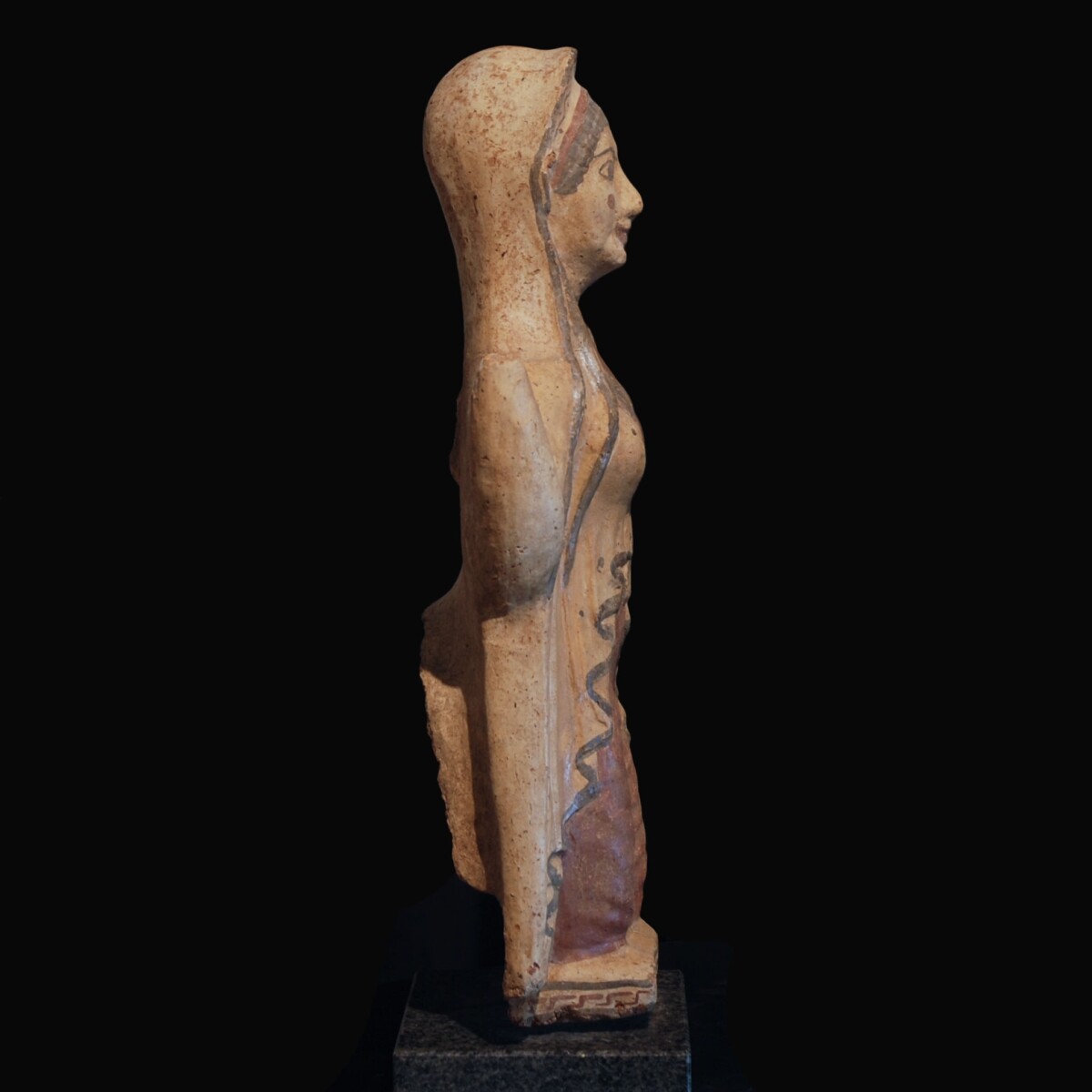
|
|
Etruria – 2nd half of 6th century B.C.
|
Magnificent archaic antefix of a kore in an ornate gown. The statue is worked out to her knees and stands on the original plinth, which is decorated with meanders on the outside. The kore wears a red, figure-hugging gown which cascades over her thighs in fine pleats. She has thrown a cape with a brown hem over her right shoulder, which covers the right breast. With the left hand she holds a tip of the cape to hip level in the style of a Greek kore. The right arm is raised, the hand missing. The kore has a roundish head with friendly, almond-shaped eyes, crowned by finely curved brows and a straight, pointy nose. The mouth is closed, the red, full lips are formed to the typical smile. On the cheeks she has red beauty spots. The black, wavy hair frames the face, in the front four long strands cascade over her shoulders to far below the round breasts. Above the forehead a towering stephane with wavy band and red dots. The back of the head is covered with a veil. Complete antefixes like the present one are extremely rare. See for the typus the very similar kore in the Fordham Museum of Greek, Etruscan and Roman Art, Bronx, New York. Mounted on a high-quality granite base. With a TL test.
|
Provenance: Private collection Carl Otto Tièche (1899-1989), Nidau, Switzerland, acquired prior to 1979. In the same year by descent to his nephew Robert Tièche, Kappel, Switzerland. In 2012 handed over by the latter to the Galleria Serodine in Ascona, Switzerland. There sold on 8 August 2012 to Dr Fred and Sylvia Legrain, Wabern, Switzerland. Thence in a family estate. With a copy of the invoice from Galleria Serodine and a provenance confirmation by Robert Tièche of 2012. With a TL test confirming the age.
Dimensions: 51 cm high
Price: 68 000 Euro
|
|
|
Etrurien – 2. Hälfte 6. Jahrhundert v. Chr.
|
Prachtvolles archaisches Antefix einer Kore im prunkvollen Gewand. Die Statue ist bis zu den Knien ausgearbeitet und steht auf ihrer Original-Plinthe, die außen mit Mäandern dekoriert ist. Die Kore trägt ein rotes, eng anliegendes Gewand, das über ihren Schenkeln feine Falten wirft. Über ihre rechte Schulter hat sie einen Umhang mit braunem Saum geworfen, der die rechte Brust bedeckt und Bauch und Schenkel freilässt. Mit der linken Hand zieht sie in Hüfthöhe im Stil der griechischen Kore einen Zipfel nach außen. Der rechte Arm ist angehoben, die Hand fehlt. Die Kore hat einen rundlichen Kopf mit freundlichen, mandelförmigen Augen, fein geschwungenen Brauen darüber und eine gerade, spitze Nase. Der Mund ist geschlossen, die roten vollen Lippen sind zu dem typischen Lächeln geformt. An den Wangen hat sie rote Schönheitspunkte. Das schwarze, wellige Haar rahmt das Gesicht ein, vorne fallen ihr vier lange Strähnen über die Schultern bis weit unter die runden Brüste. Über die Stirn ragt eine Stephane mit Wellenband und roten Punkten. Der Hinterkopf ist von einem Schleier verhüllt. Komplette Antefixe wie dieses sind außerordentlich selten. Vergleiche zum Typus die sehr ähnliche Kore im Fordham Museum of Greek, Etruscan and Roman Art, Bronx, New York. Auf hochwertigem Granitsockel montiert. Mit TL-Test.
|
Provenienz: Privatsammlung Carl Otto Tièche (1899-1989), Nidau, Schweiz, erworben vor 1979. In diesem Jahr durch Erbschaft an seinen Neffen Robert Tièche, Kappel, Schweiz. Von diesem 2012 an die Galleria Serodine in Ascona, Schweiz, übergeben. Dort verkauft am 8. August 2012 an Dr. Fred und Sylvia Legrain, Wabern, Schweiz. Seitdem in Familienbesitz. Mit Kopie der Rechnung der Galleria Serodine und Provenienzbestätigung von Robert Tièche aus dem Jahr 2012. Mit TL-Test, der das Alter bestätigt.
Höhe: 51 cm
Preis: 68.000 Euro
|
|
|
|
Selected Artworks of the Month:
|

|
|
|
|
|
|
Egypt – Ptolemaic period, 332-30 B.C.
|
Large wood statuette of Isis lactans with remains of gilding dating to the Ptolemaic period. The goddess is seated in her throne with a set off, short backrest and holds with her right hand her left breast. In today’s missing left hand she held the separately worked out and today also missing Horus boy to breastfeed him. The breasts are notably large and round. Isis wears a tripartite wig and a body-hugging gown which reaches to the ankles. The legs are separately worked out, there is an old wood tenon in the plinth. The figure is thinly covered with plaster and gilded on top. Especially on the upper body and right arm the remains of gilding are preserved. The eyes with the striking lid line are inlayed in bronze. The uraeus serpent on the forehead, as well as the Hathor crown with the uraeus wreath, sun disk and cow horns are also worked out in bronze and inserted. The throne is painted on both sides with a scales motive, referring to raising the child Horus in the papyrus thicket of the Delta. The statue was once placed in a naos (shrine) of an Isis temple. The statue was worshiped as if she was the goddess herself. See for the typus the Isis statuette in the Harvard Art Museum with the object number 1960.464. Mounted.
|
Provenance: Belgian private collection G. Acquired in the 1990s from the gallery Drees Archeo in Brussels. Accompanied by the original certificate.
Dimensions: 28.7 cm high
Price: 16 000 Euro
|
|
|
Ägypten – Ptolemäische Zeit, 332-30 v. Chr.
|
Große Holzstatuette der säugenden Isis mit Resten von Vergoldung aus ptolemäischer Zeit. Die Göttin sitzt auf ihrem Thron mit abgesetzter, kurzer Rückenlehne und hält mit ihrer rechten Hand ihre linke Brust. In der heute fehlenden linken Hand hielt sie den separat gearbeiteten und heute ebenfalls fehlenden Horus-Knaben, um ihn zu säugen. Die Brüste sind auffallend groß und rund. Isis trägt eine dreigeteilte Perücke und ein enganliegendes Kleid, das bis zum Knöchel reicht. Die Beine sind separat gearbeitet, in der Plinthe steckt noch ein alter Holzstift. Die Figur ist dünn mit Gips überzogen und darüber vergoldet. Vor allem am Oberkörper und am rechten Arm haben sich noch Reste der Vergoldung erhalten. Die Augen mit dem markanten Lidstrich sind in Bronze eingelegt. Die Uräus-Schlange auf der Stirn sowie die Hathorkrone mit Uräuskranz, Sonnenscheibe und Kuhhörnern sind ebenfalls in Bronze gearbeitet und eingesteckt. Der Thron ist auf beiden Seiten mit einem Schuppenmotiv bemalt, das sich auf das Aufziehen des Kindes Horus im Papyrusdickicht im Delta von Khemnis bezieht. Diese Statue wurde im Naos (Schrein) eines Isis-Tempels aufgestellt. Die Statue wurde verehrt, als wäre sie die Göttin selbst. Vergleiche zum Typus die Isis-Statuette im Harvard Art Museum mit der Objektnummer 1960.464. Gesockelt.
|
Provenienz: Belgische Privatsammlung G. Erworben in den 1990er Jahren in der Galerie Drees Archeo in Brüssel. Mit Original-Zertifikat.
Höhe: 28,7 cm
Preis: 16.000 Euro
|
|
|
|
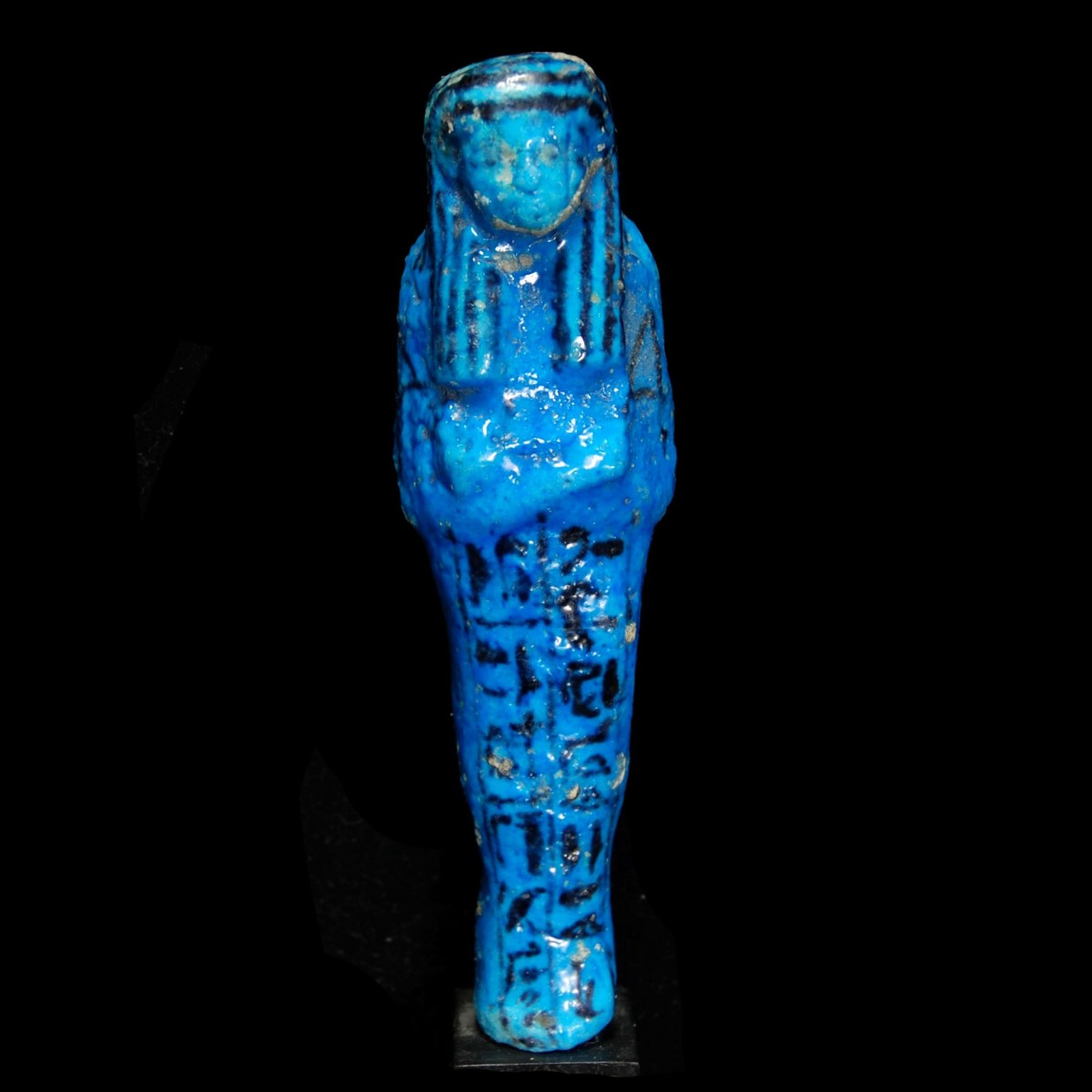
|
|
|
|
|
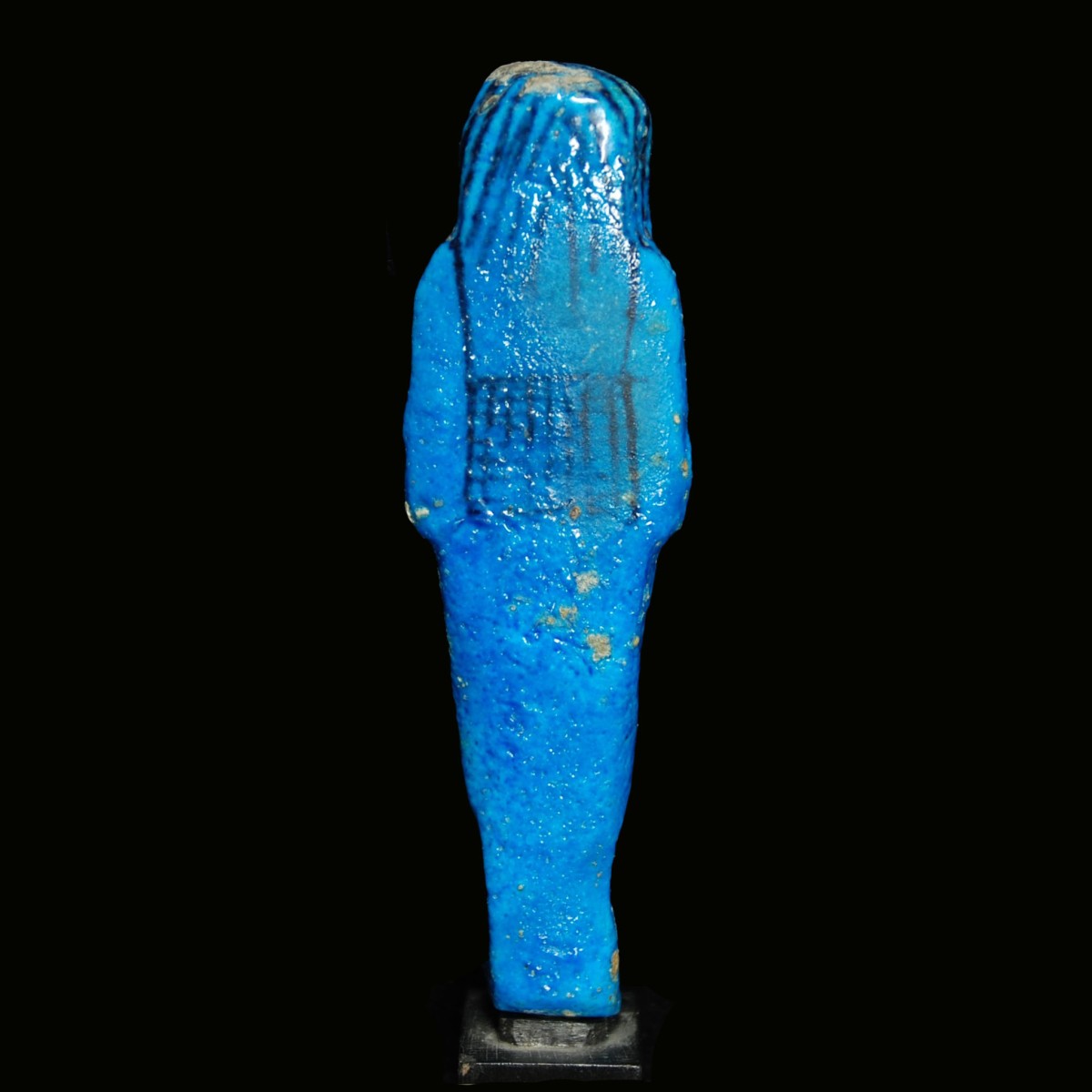
|
|
Egypt – 3rd Intermediate period, late 21st dynasty, 970-931 B.C.
|
Large shabti of blue glazed faience, which belonged to the tomb endowment of the priest Nesi-per-Neb (also Nes-per-nubu or Nespernub) that was found in 1891 in the cache at Bab el Gasus (also known as “Priestly Cache” or "2nd Cache). Nesi-per-Neb whose name means “He who belongs to the House of Gold”, had numerous titles. Amongst them namely “Godfather of Amun and Scribe of the Temple of Mut” are mentioned on this shabti. Today, around 80 shabtis (around 30 in private hands) of Nesi-per-Neb, whose coffin is in the Kunsthistorisches Museum in Vienna, are known. They differ in their inscription and painting. An example with the long, two-column inscription such as on the present one is in the Musée historique de Vevey in Switzerland with the inventory number A 131. Regarding the description: The mummiform figure has the arms crossed over the chest, each hand holding a hoe. It wears a tripartite wig with a filet, as well as horizontal stripes on the calotte and vertical ones on the lobes. Eyes, brows, collar and the seed bag on the back are painted in black, mouth and nose are sculptural. The hieroglyphs mention the name of the owner, two of his titles, as well as the tasks of the tomb servants, which are: “Oh shabti, say: I will water (the bank areas).” The right column mentions rare excerpts of Chapter 83 of the Book of the Dead, which is about the transformation to a phoenix. For a fundamental work about the shabtis of Nes-per-nebu see Niek de Haan and Patrice Renaut “The shabtis of Nesy-per-nub”, First Edition 2021, published on shabticollections.com.
|
Provenance: Found in 1891 in the cache of Bab-el-Gasus (2nd cache at Dei el Bahari). Thence in a French private collection. Auctioned on 16 November 1987 with Delavenne et Lafarge in Paris, lot 132. From there acquired by the collection Chauvin, Paris. Accompanied by a French antiquities passport.
Dimensions: 14.7 cm high
|
|
|
Ägypten – 3. Zwischenzeit, späte 21. Dynastie, 970-931 v. Chr.
|
Großes Uschebti aus blau glasierter Fayence, das zur Grabausstattung des Priesters Nes-per-nebu (auch Nesy-per-nub oder Nespernub) gehörte und 1891 in der Cachette von Bab el-Gasus („Priesterpforte“) gefunden wurde. Nes-per-nebu, dessen Name „Derjenige, der zum Haus des Goldes gehört“ bedeutet, hatte zahlreiche Titel. Zwei davon, nämlich „Pate des Amun und Schreiber des Tempels der Mut“, werden auf diesem Uschebti genannt. Heute sind rund 80 Shabtis (rund 30 in Privatbesitz) des Nes-Per-nebu, dessen Sarg sich im Kunsthistorischen Museum in Wien befindet, bekannt. Sie unterscheiden sich in Inschrift und Bemalung. Ein Exemplar, mit der langen, zweispaltigen Inschrift wie unseres befindet sich im Musée historique de Vevey in der Schweiz mit der Inventarnummer A 131. Zur Beschreibung: Die mumienförmige Figur hat über der Brust gekreuzte Arme, die jeweils eine Hacke halten. Sie trägt eine dreiteilige Perücke mit Stirnband sowie horizontalen Streifen auf der Kalotte und vertikalen an den Lappen. Augen, Brauen, Halsschmuck und das Saatgutsäckchen am Rücken sind in Schwarz aufgemalt, Mund und Nase treten plastisch hervor. Die Hieroglyphen nennen den Namen des Besitzers, zwei seiner Titel sowie die Aufgabe des Grabdieners, die lautet: „Oh Uschebti, sag: Ich werde (die Ufergebiete) bewässern.“ Die rechte Spalte nennt seltene Auszüge aus Kapitel 83 aus dem Totenbuch, in denen es um die Transformation in einen Phoenix geht. Eine grundlegende Arbeit zu den Uschebtis des Nes-per-nebu siehe Niek de Haan und Patrice Renaut „The shabtis of Nesy-per-nub“, First Edition 2021, publiziert auf shabticollections.com.
|
Provenienz: Gefunden 1891 in der Cachette von Bab-el-Gasus (2. Cachette von Deir el Bahari). Danach französische Privatsammlung. Versteigert am 16. November 1987 bei Delavenne et Lafarge in Paris, Los 132. Dort erworben von der Sammlung Chauvin, Paris. Mit französischem Antikenpass.
Höhe: 14,7 cm
Preis: 12.000 Euro
|
|
|
|
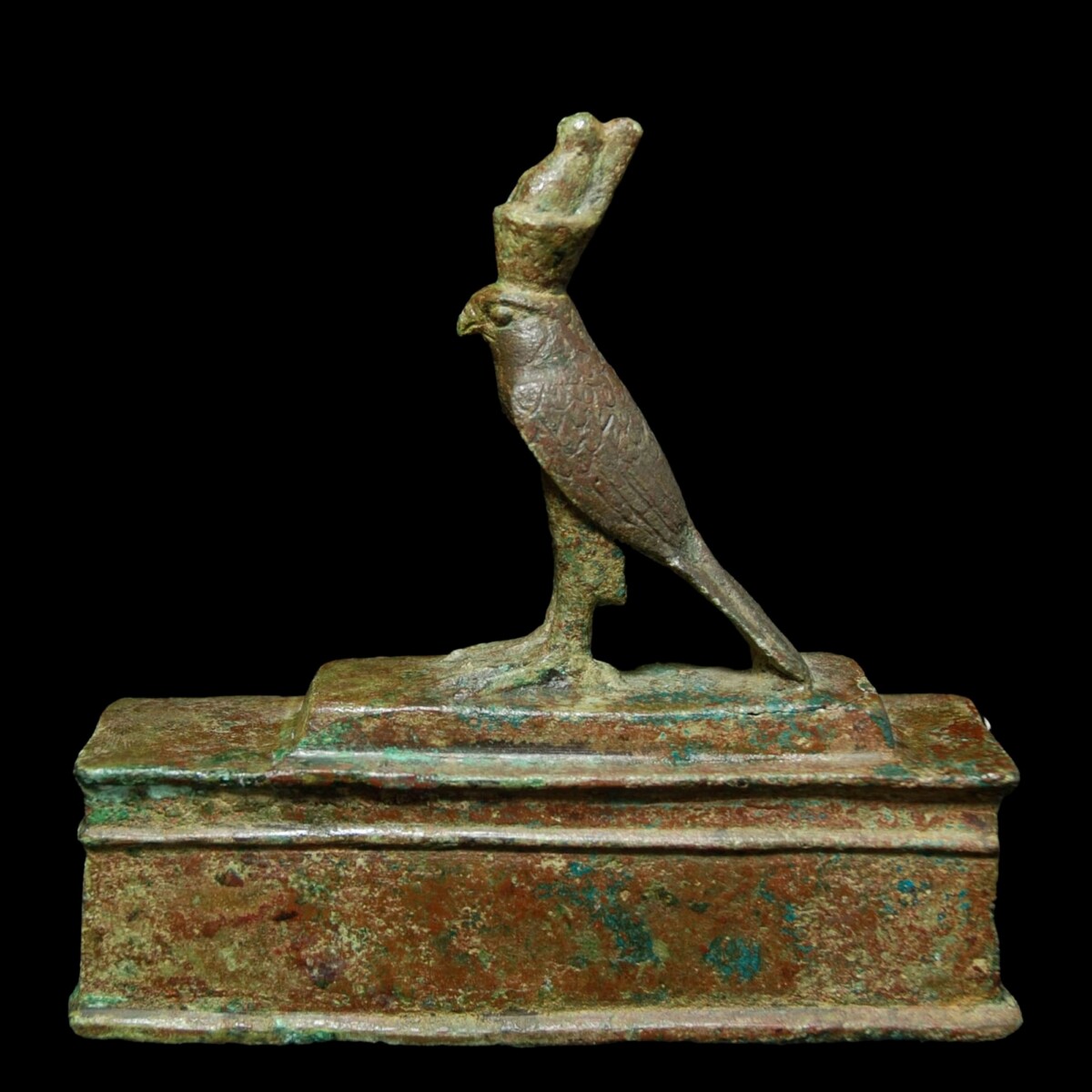
|
|
|
|
|
|
Egypt – Late period, 26th-30th dynasty, 664-343 B.C.
|
Impressive animal sarcophagus with slightly inwardly angled outer walls and set off lid which once held the mummy of a sacred falcon. On the rectangular plate on the lid sits a high quality, massive bronze statuette of the god Horus in form of a falcon. He wears the Pschent, the double crown of Upper- and Lower Egypt. His wings are resting and abundantly decorated, the tail feathers are crossed in the back. His vigilant round eyes look straight forward. The sarcophagus was sealed in the back with a thin copper plate after the falcon mummy had been put inside. As with most of these bronze sarcophagi the mummy was removed in the meantime, the rear cover at the back was lost. See for the type the falcon sarcophagus in the Brooklyn Museum with the Accession Number 37.416Ea-b. There were falcon cults all over Egypt and the god Horus in particular was worshiped in many places as the son of Isis and Osiris. Thousands of falcons were mummified and buried in animal necropolises. While the mummies were mostly wrapped in linen, adorned with cartonnage heads and buried like this, bronze sarcophagi such as the present one were notably rarer.
|
Provenance: On the bottom an old label of the gallery Olivier Tiano "HIER et AILLEURS", 1980s. From there acquired by the collection M. R. S., Bordeaux. Last with Bonhams auction Paris on 7 October 2021, lot 126. Accompanied by a French antiquities passport.
Dimensions: 14.5 cm x 14.6 cm
Price: 12 000 Euro
|
|
|
Ägypten – Spätzeit, 26.-30. Dynastie, 664-343 v. Chr.
|
Eindrucksvoller Tier-Sarkophag mit leicht nach innen geneigten Außenwänden und abgesetztem Deckel, der einst die Mumie eines heiligen Falken beherbergte. Auf einer rechteckigen Platte am Deckel sitzt eine hochwertig gearbeitete, massive Bronze-Statuette des Gottes Horus in Form eines Falken. Er trägt die Pschent, die Doppelkrone für Ober- und Unterägypten. Seine Flügel sind angelegt und reich verziert, die Schwanzfedern überkreuzen sich hinten. Seine wachen runden Augen blicken erhaben gerade aus. Der Sarkophag wurde hinten mit einer dünnen Kupferplatte versiegelt, nachdem die Mumie eines Falken hineingelegt wurde. Wie bei den meisten dieser Bronze-Sarkophage wurde die Mumie in der Zwischenzeit entfernt, die Abdeckung hinten ging dabei verloren. Vergleiche dazu den Falken-Sarkophag im Brooklyn Museum mit der Accession Number 37.416Ea-b. Falken-Kulte gab es in ganz Ägypten und speziell der Gott Horus wurde als Sohn der Isis und des Osiris vielerorts verehrt. Falken wurden dafür zu Tausenden mumifiziert und in den Tier-Nekropolen bestattet. Während die Mumien zumeist in Leinen gewickelt und mit Kartonnage-Köpfen versehen und abgelegt wurden, sind Bronze-Sarkophage wie dieser deutlich seltener.
|
Provenienz: Auf der Unterseite ein altes Etikett der Galerie Olivier Tiano „HIER et AILLEURS“, 1980er Jahre. Dort erworben von der Sammlung M. R. S., Bordeaux. Zuletzt Bonhams Auktion Paris am 7. Oktober 2021, Los 126. Mit französischem Antikenpass.
Dimensionen: 14,5 cm x 14,6 cm
Preis: 12.000 Euro
|
|
|
|
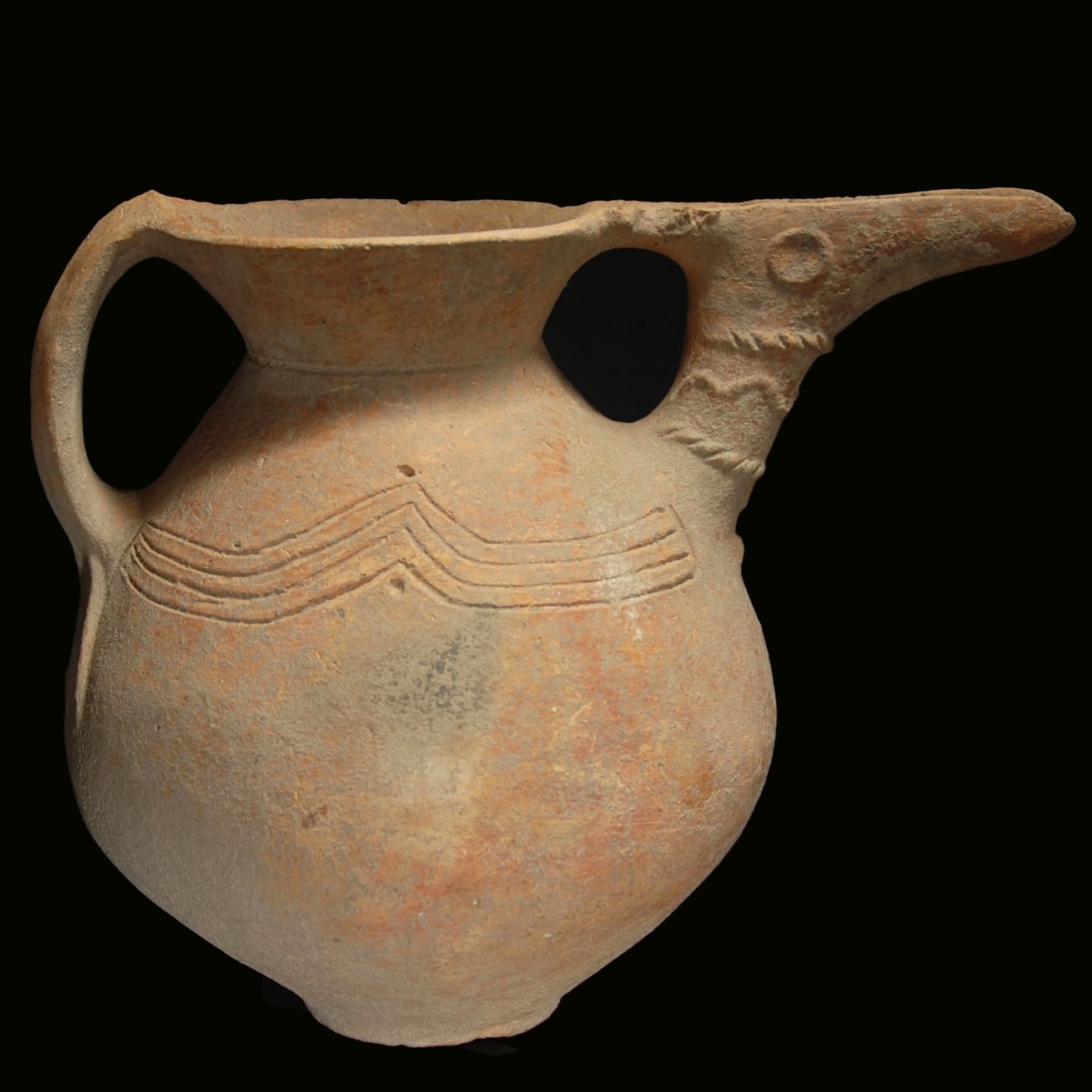
|
|
|
|
|
|
|
Very beautifully preserved and large beak-spouted jug of light clay with a zoomorphic spout. The bulbous body stands on a slightly set off foot ring. The upper half is decorated with four parallel engraved bands that form a wave. Above and below the wave an engraved dot. In the front a separately worked out spout rises from the wall. String ornaments are applied in high relief on the neck. The spout itself has a slit-shaped opening, round eyes make it look like a stylized bird’s head. An x-shaped bridge at the top connects the spout with the large pouring hole at the top. The bridge is decorated with dots and lines at the top. On the back of the funnel-shaped pouring hole the semi-circular handle with a central ridge rises above. It ends on the shoulder and fades in three protruding ribs which should symbolize bird crawls. An extraordinarily beautiful beak-spouted jug from the northwestern Iranian region. Similar jugs were made from around 1400 to 800 B.C. from the central Persian region to Anatolia, with those with engraved decoration being found primarily in the northwest on the border with Azerbaijan. Compare other beak-spouted jugs in the Harvard Art Museum with the object number 1937.12, in the British Museum with the registration number 1933,1211.1 or in the Smithsonian National Museum of Asian Art with the accession number S2014.1.
|
Provenance: German private collection, O. Schwarzwälder since 1980.
Dimensions: 23.3 cm high
Price: 1 800 Euro
|
|
Besonders schön erhaltene und große Schnabelkanne aus hellem Ton mit zoomorphem Ausguss. Der kugelige Korpus steht auf einem leicht abgesetzten Standring Die obere Hälfte ist mit vier parallel verlaufenden, eingravierten Bändern verziert, die eine Welle bilden. Über und unter der Welle ein gravierter Punkt. Vorne erhebt sich der separat gespeiste Ausguss aus der Wandung. Am Hals sind im erhabenen Relief Schnurornamente aufgelegt. Der Ausguss selbst ist oben schlitzförmig geöffnet, runde Augen am Ansatz verleihen ihm das Aussehen eines stilisierten Vogelkopfes. Der Ausguss ist oben über einen X-förmigen Steg mit dem großen Einfüllloch verbunden. Der Steg ist oben mit Punkten und Linien verziert. Auf der Rückseite des trichterförmigen Einfüllloches setzt der halbrunde Henkel mit Mittelgrat an. Er endet an der Schulter und läuft in drei abstehenden Rippen aus, die Vogelkrallen symbolisieren sollen. Eine außergewöhnliche schöne Schnabelkanne aus dem nordwestiranischen Raum. Ähnliche Kannen wurden von etwa 1400 bis 800 v. Chr. vom zentralpersischen Raum bis Anatolien hergestellt, wobei die jene mit graviertem Dekor vor allem im Nordwesten an der Grenze zu Aserbaidschan gefunden wurden. Vergleiche weitere Schnabelkannen im Harvard Art Museum mit der Objektnummer 1937.12, im British Museum mit der Registration Number 1933,1211.1 oder im Smithsonian National Museum of Asian Art mit der Accession Number S2014.1.
|
Provenienz: Deutsche Privatsammlung, O. Schwarzwälder seit 1980.
Höhe: 23,3 cm
Preis: 1.800 Euro
|
|
|
|
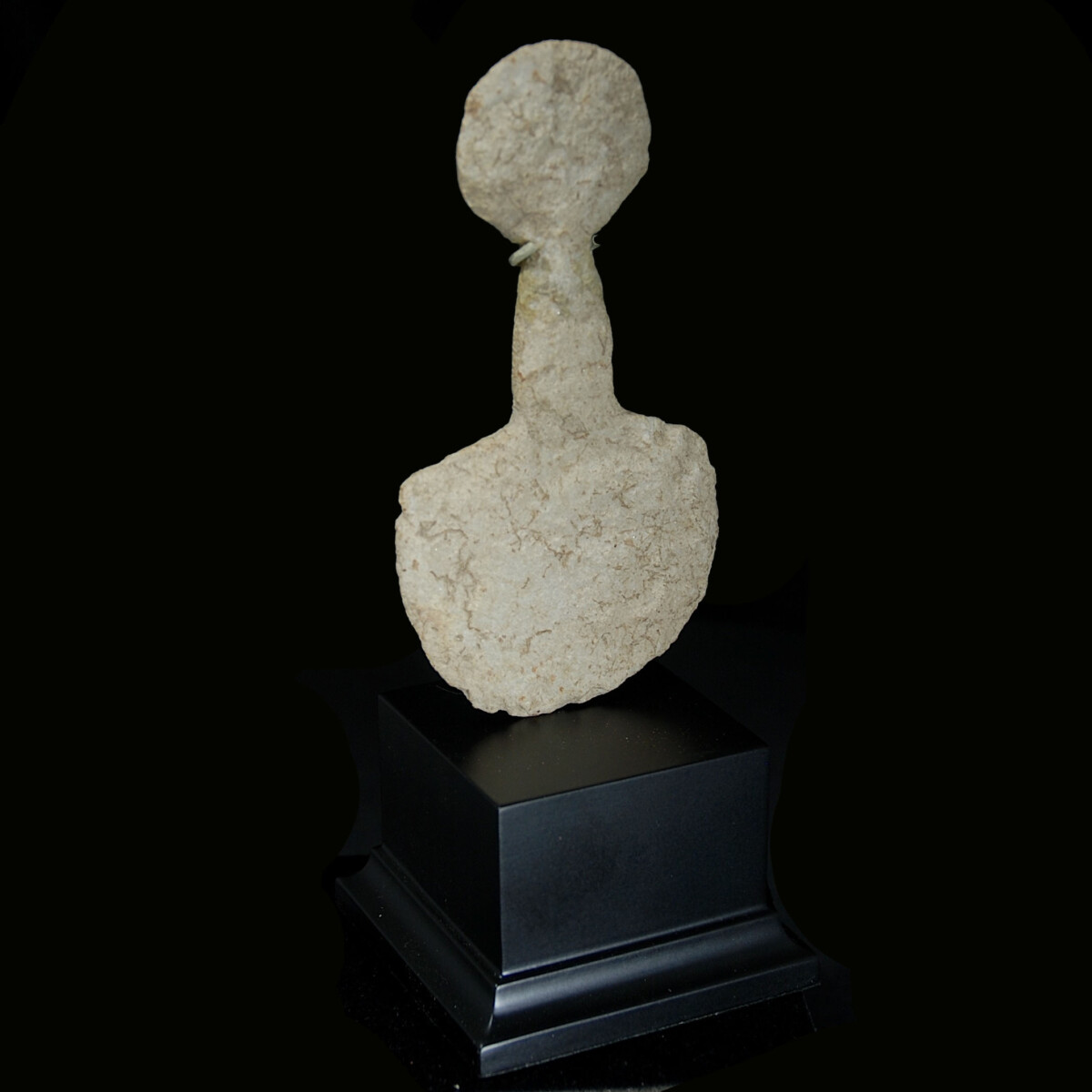
|
|
|
|
|
|
Anatolia – 2700-2400 B.C.
|
Charming Anatolian marble idol of the so-called Kusura type. The fertility statuettes, also known as violin idols because of their shape, come from the west coast of Asia Minor and have been attested far into the mainland. They are contemporaries of the famous Cycladic idols. Our specimen belongs to the early form without arms and locks of hair. From the circular head, the strong, straight neck widens downwards and, sloping slightly, merges directly into the disc-shaped body, rounded at the bottom in fine harmony. The idol is extraordinarily thinly crafted and almost translucent, it probably had a special meaning in the fertility rite. Experts believe that the idols were ritually broken in the rite, which is why most Kusura statuettes today are reassembled at the neck. See for the type “Art and Culture of the Cyclades”, exhibition catalog of the Baden State Museum Karlsruhe, 1976, No. 495, shown on p. 380, described on p. 549. Mounted.
|
Provenance: French private collection, acquired at least in the 1970s. Thence Bonhams auction London on 23rd October 2012, lot 204. Last in an English collection in Cambridgeshire.
Dimensions: 13 cm high
Price: 2 400 Euro
|
|
|
Anatolien – 2700-2400 v. Chr.
|
Reizvolles anatolisches Marmor-Idol des sogenannten Kusura-Typs. Die aufgrund ihrer Form auch Violin-Idole genannten Fruchtbarkeits-Statuetten stammen von der Westküste Kleinasiens und sind weit bis ins Hinterland bezeugt. Sie sind Zeitgenossen der berühmten Kykladen-Idole. Dieses Exemplar gehört zur frühen Form ohne Arme und Haarlocken. Vom kreisrunden Kopf aus verbreitert sich der kräftige, gerade Hals nach unten und geht leicht abfallend direkt in den scheibenförmigen, unten in feiner Harmonie abgerundeten Körper über. Das Idol ist außerordentlich dünn gearbeitet, geradezu lichtdurchscheinend hatte es im Fruchtbarkeitsritus wohl besondere Bedeutung. Experten gehen davon aus, dass die Idole im Ritus rituell gebrochen wurden, weshalb die meisten Kusura-Statuetten am Hals zusammengesetzt sind. Vergleiche zum Typus „Kunst und Kultur der Kykladen“, Ausstellungskatalog des badischen Landesmuseums Karlsruhe, 1976, Nr. 495, abgebildet auf S. 380, beschrieben auf S. 549. Gesockelt.
|
Provenienz: Französische Privatsammlung, zumindest seit den 1970er Jahren. Danach bei Bonhams London am 23. Oktober 2012, Los 204. Zuletzt in einer englischen Sammlung in Cambridgeshire.
Höhe: 13 cm
Preis: 2.400 Euro
|
|
|
|

|
|
|
|
|
Large terracotta bowl on a high foot ring which swings out in a trumpet shape at the bottom. The vessel is made of beige clay with a red-brown, geometric painting. Thick reddish-brown bands are painted around the foot and about halfway down the body. Star decoration all around the foot and a finely drawn braided band under the rim, lending the bowl a special elegance. Stripe-decoration on the outside of the rim. Wide bands on the inside of the bowl, in the tondo a painted, reddish-brown circle. On one side, under the rim are two ancient perforations, probably for hanging in a tomb context. The completely intact vessel can be attributed to the Heron Class, which often had stylized herons painted under the rim. Large footed bowls like the present one were found primarily in southern Etruria, but they were probably made in Caere or Vulci. For the type, compare the footed bowl in the Metropolitan Museum of Art with the Accession Number 59.141.
|
Provenance: Viennese collection Zweymüller, acquired in the 1970s. Last in the collection Stefan Horn.
Dimensions: 22.8 cm high; 25 cm in diameter
Price: 2 400 Euro
|
|
|
Etrurien – 625-600 v. Chr.
|
Große Terrakotta-Schale auf hohem Standfuß, der unten trompetenförmig ausschwingt. Das Gefäß aus beigem Ton mit rotbauner, geometrischer Bemalung. Um den Fuß und etwa in der Hälfte des Korpus sind dicke rotbraune Bänder aufgemalt. Über dem Fuß umlaufendes Sterndekor und unter dem Rand ein fein gezogenes Flechtband, das der Schale eine besondere Eleganz verleiht. Am Rand außen Streifendekor. Im Inneren der Schale breite Bänder, im Tondo ein ausgemalter, rotbrauner Kreis. Auf einer Seite unter dem Rand sind zwei antike Lochungen, wohl zur Aufhängung im Grabkontext. Das komplett intakte Gefäß ist der Heron-Klasse zuzuordnen, die unter dem Rand häufig stilisierte Reiher (englisch „Heron“) aufmalte. Große Fußschalen wie diese wurden vor allem im südlichen Etrurien gefunden, hergestellt wurden sie aber vermutlich in Caere oder Vulci. Vergleiche zum Typus die Fußschale im Metropolitan Museum of Art mit der Accession Number 59.141.
|
Provenienz: Wiener Sammlung Zweymüller, erworben in den 1970er Jahren. Danach in der Sammlung Stefan Horn.
Höhe: 22,8 cm; Durchmesser Schale: 25 cm
Preis: 2.400 Euro
|
|
|
|
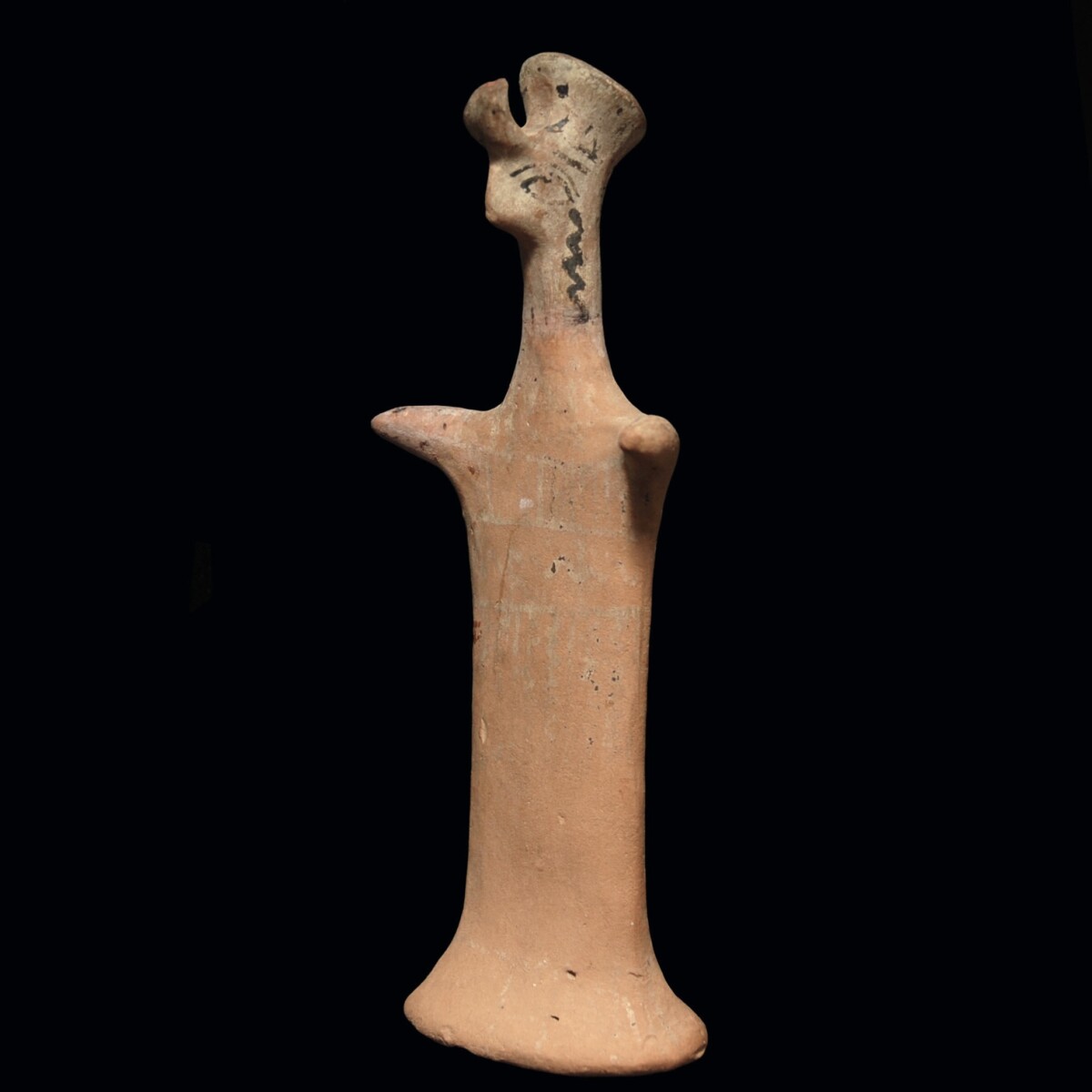
|
|
|
|
|
|
Greece/Boeotia – Mid 6th century B.C.
|
Plank idol with a flat body formed by hand, merging at the bottom to an oval foot ring and on top to a cylindrical neck. The bird-like face with a beak-shaped nose and red painted eyes. The figure wears a cupped polos at the back of the head identifying her as a goddess. On the forehead a large, inwardly rolled volute, suggesting a quiff. The short arms are protruding on the sides, slightly bent forward and tapering. On the sides long, wavy hair strands cascade on the sides to the shoulder. On the back the collection number “13” is written with a pencil. Idols such as the present one possibly represent goddesses (Demeter or Hera). Due to their headdress they are also called Papades. See for the typus the statuette in the Metropolitan Museum of Art with the Accession Number 52.11.1.
|
Provenance: German private collection J. Gutbrod (died in 2017), acquired in the 1960s to the 1990s in the German art market. Thence by descent to Micaela Gutbrod, Munich.
Dimensions: 16.7 cm high
Price: 900 Euro
|
|
|
Griechenland/Böotien – Mitte 6. Jahrhundert v. Chr.
|
Handgeformtes Brettidol mit flachem Körper, der nach unten zu einem ovalen Standring ausschwingt und nach oben in einen zylindrischen Hals übergeht. Das vogelähnliche Gesicht mit schnabelförmiger Nase und in schwarzer Farbe aufgemalten Augen. Die Figur trägt einen schalenförmigen Polos am Hinterkopf, der sie als Göttin ausweist. Auf der Stirn hat sie eine Volute, die wohl als Haartolle zu deuten ist. Die kurzen Arme sind seitlich weggestreckt, leicht nach vorne gebogen und spitz auslaufend. Seitlich fallen der Göttin in Schwarz aufgemalte lange, gewellte Haarsträhnen auf die Schulter. Auf der Unterseite ein altes Sammlungsetikett mit der Aufschrift „Cypern, 10.-9. Jahrhundert v. Chr.). Am Rücken die Sammlungsnummer „13“ mit Bleistift aufgetragen. Idole wie dieses stellen vermutlich Göttinnen (Demeter oder Hera) dar. Sie werden aufgrund des Kopfschmucks auch als Papades bezeichnet. Vergleiche zum Typus die Statuette im Metropolitan Museum of Art mit der Accession Number 52.11.1.
|
Provenienz: Deutsche Privatsammlung J. Gutbrod (verstorben 2017), erworben in den 1960er bis 1990er Jahren am deutschen Kunstmarkt. Danach durch Erbe an Micaela Gutbrod, München.
Höhe: 16,7 cm
Preis: 900 Euro
|
|
|
|
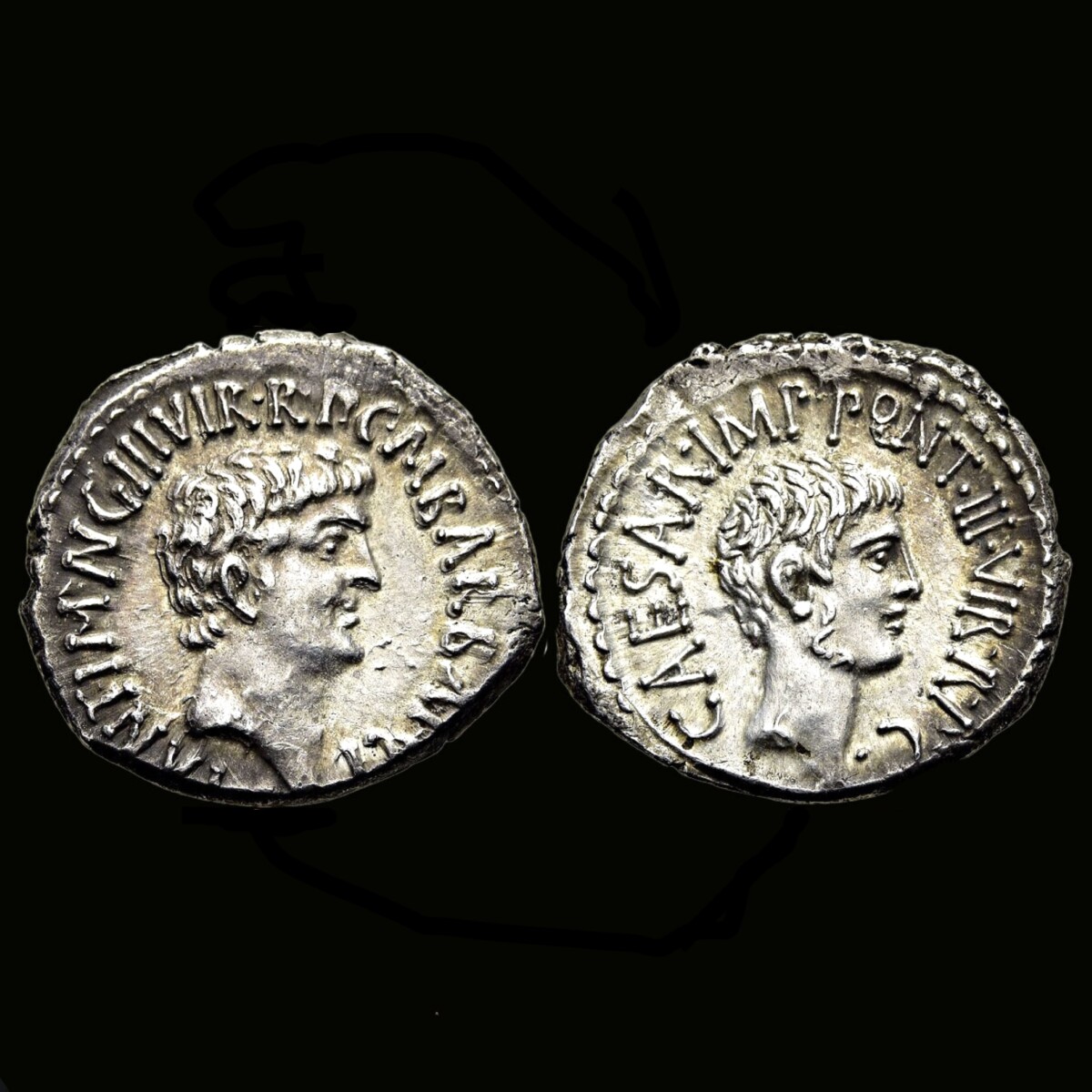
|
Denarius of a field mint of Mark Antony depicting his portrait on the obverse in a circle of beads. The inscription – partially in ligature – reads: M(ARCO) ANT(ONIO) IMP(ERATORI) A[VG(VRI) III VIR(O) R(EI) P(VBLICAE) C(ONSTITVENDAE) M(ARCVS)] BARBAT(IVS) Q(VAESTOR PRO) P(RAETORE). It not only mentions Mark Antony, but also his office as an augur and his role as a member of the Triumvirate to reestablish the Republic. Last the legend also mentions Marcus Barbatius Pollio, who in 41 A.D. was questor pro praetore under Mark Antony. Depicted on the reverse is the portrait of young Octavian with whisker. The later first Roman emperor Augustus also facing to the right and inside a circle of beads. The legend reads CAESAR(I) IMP(ERATORI) PONT(IFICI) III VIR(O) R(EI) P(VBLICAE) C(ONSTITVENDAE) and mentions him also as a member of the Triumvirate. Both portraits of excellent quality. Both portraits of excellent quality.
|
Provenance: German collection, acquired at Papillon Numismatic auction 8, London 2021, lot 338.
Dimensions: 2 cm in diameter; 3.9 gram
Price: 3 800 Euro
|
|
|
Römisches Reich – 41 v. Chr.
|
Denar aus einer Feldmünzstätte des Marcus Antonius, die sein Porträt auf der Vorderseite in einem Perlkreis zeigt. Die Münzumschrift – teilweise in Ligatur – lautet: M(ARCO) ANT(ONIO) IMP(ERATORI) A[VG(VRI) III VIR(O) R(EI) P(VBLICAE) C(ONSTITVENDAE) M(ARCVS)] BARBAT(IVS) Q(VAESTOR PRO) P(RAETORE). Sie nennt damit nicht nur Marcus Antonius, sondern auch sein Amt als Augur und seine Rolle als Mitglied des Triumvirats zur Wiederherstellung der Republik. Zuletzt nennt die Legende auch Marcus Barbatius Pollio, der 41 n. Chr. quaestor pro praetore unter Marcus Antonius war. Auf dem Revers ist das Porträt des jungen Octavian mit Backenbart abgebildet. Der spätere erste römische Kaiser Augustus blickt ebenfalls nach rechts und befindet sich in einem Perlkreis. Die Legende lautet CAESAR(I) IMP(ERATORI) PONT(IFICI) III VIR(O) R(EI) P(VBLICAE) C(ONSTITVENDAE) und führt auch ihn als Mitglied des Triumvirats an. Beide Porträts von exzellenter Qualität.
|
Provenienz: Deutsche Sammlung, erworben in der Papillon Numismatic Auktion 8, London 2021, Los 338.
Durchmesser: 2 cm; Gewicht: 3,9 Gramm
Preis: 3.800 Euro
|
|
|
|

|
|
|
|
|
|
Roman Empire – 2nd century A.D.
|
Roman plate made of almost completely discolored clear glass. The edge is drawn far outwards, hot rounded and folded inwards. The wall initially stands out horizontally from the edge and then runs almost vertically before merging into the floor in a fine curve. The plate stands on a low foot ring pinched out of the wall, which is also hot-rounded on the edge. The underside of the floor is concave and forms an omphalos curvature in the tondo. Mounted.
|
Provenance: Private collection Dr. Peter Rudeck, Vienna, Austria. Acquired on 17 February 1995 from Gerhard Herinek in Vienna. With the original certificate.
Dimensions: 16 cm in diameter
Price: 1 200 Euro
|
|
|
Römisches Reich – 2. Jahrhundert n. Chr.
|
Römischer Teller aus nahezu komplett entfärbtem Klarglas. Der Rand ist weit nach außen gezogen, heiß verrundet und nach innen umgeschlagen. Die Wand setzt sich zunächst horizontal vom Rand ab und verläuft dann fast senkrecht, ehe sie in einer feinen Rundung in den Boden übergeht. Der Teller steht auf einem aus der Wandung gekniffenen, niedrigen Standring, der ebenfalls am Rand heiß verrundet ist. Die Bodenunterseite ist konkav und bildet im Tondo eine Omphalos-Wölbung. Gesockelt.
|
Provenienz: Privatsammlung Dr. Peter Rudeck, Wien. Erworben am 17. Februar 1995 bei Gerhard Herinek in Wien. Mit Original-Zertifikat.
Durchmesser: 16 cm
Preis: 1.200 Euro
|
|
|
|
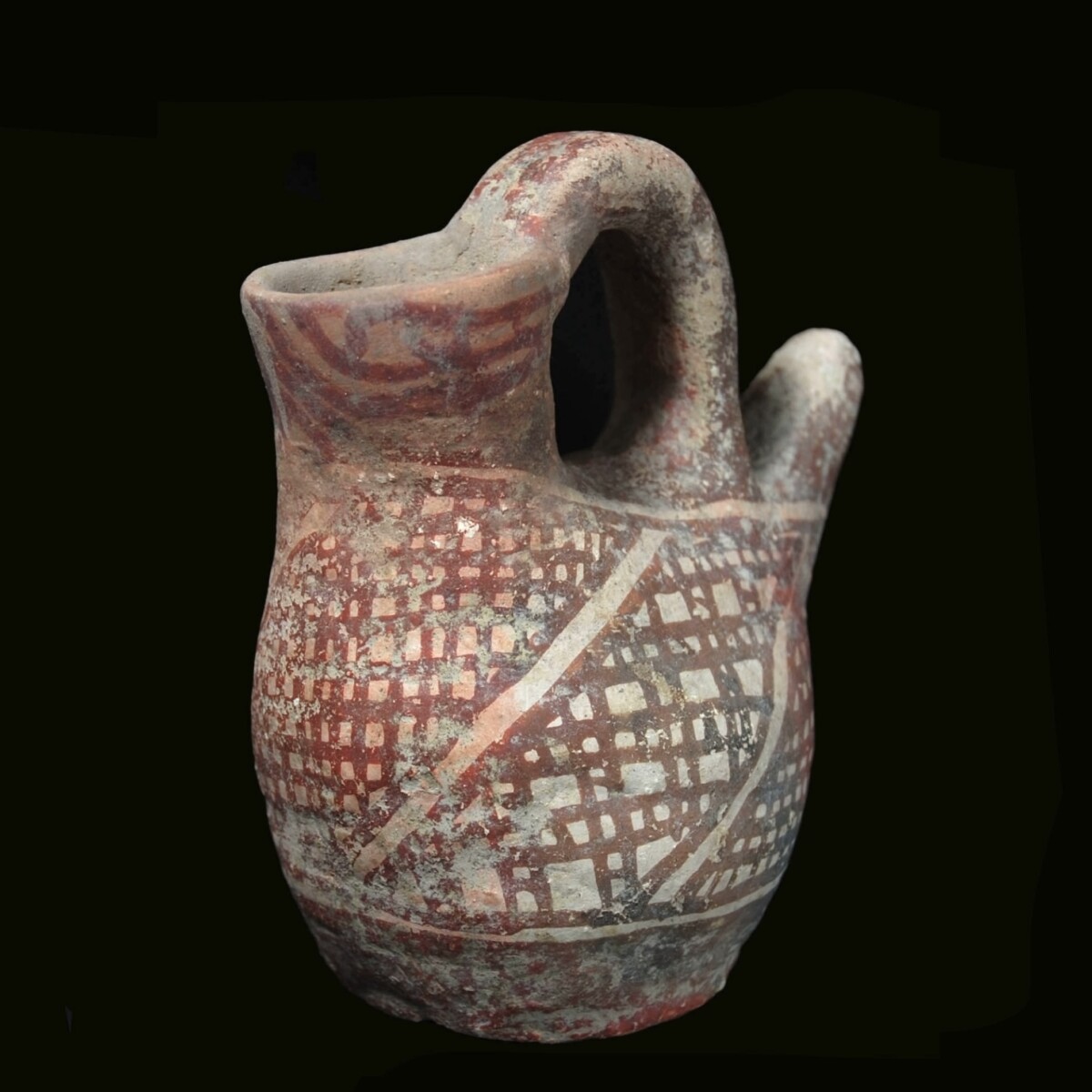
|
|
|
|
|
Vessel formed by hand in form of a stylized bird. The corpus is bulbous and stands on a flat base. The large round pouring hole stands for the head, the elongated spout for the tail. From the rim of the head a semicircular handle curves to the back. The entire vessel is painted in red-brown colour. The corpus is decorated with a dense net pattern. On the pouring hole on the outside eyes and features are painted. Handle and tail are painted in large scale. See for the painting the zoomorphic askos in the Metropolitan Museum of Art in New York with the Accession Number 74.51.795, as well as for the form the askoi in the British Museum with the numbers 1982,0726.8 and 1876,0909.9.
|
Provenance: From the collection of Peter Eichhorn, Germany, acquired in the 1970s to 1980s.
Dimensions: 14 cm high
Price: 800 Euro
|
|
|
Zypern – 1750-1650 v. Chr.
|
Handgeformtes Gefäß in der Form eines stilisierten Vogels. Der Korpus ist bauchig und steht auf einer flachen Basis. Das große runde Einfüllloch steht für den Kopf, der langgezogene Ausguss für den Schwanz. Vom Rand des Kopfes schwingt sich ein halbrunder Henkel mit zum Rücken. Das gesamte Gefäß ist mit rotbrauner Farbe bemalt. Der Korpus ist dabei mit einem dichten Netzmuster verziert. Am Einfüllloch sind außen Augen und Gesichtszüge aufgemalt. Henkel und Schwanz sind flächig bemalt. Vergleiche zur Bemalung den zoomorphen Askos im Metropolitan Museum of Art in New York mit der Acession Number 74.51.795 sowie zur Form die Askoi im British Museum mit der Nummer 1982,0726.8 sowie 1876,0909.9.
|
Provenienz: Aus der Sammlung Peter Eichhorn, Deutschland, erworben in den 1970er bis 1980er Jahren.
Höhe: 14 cm
Preis: 800 Euro
|
|
|
|
|
|
|
CHRISTOPH BACHER ARCHÄOLOGIE ANCIENT ART GmbH
|
Galerie: Stubenring 20, A-1010 Wien
Showroom: Untere Viaduktgasse 55, A-1030 Wien
|
|
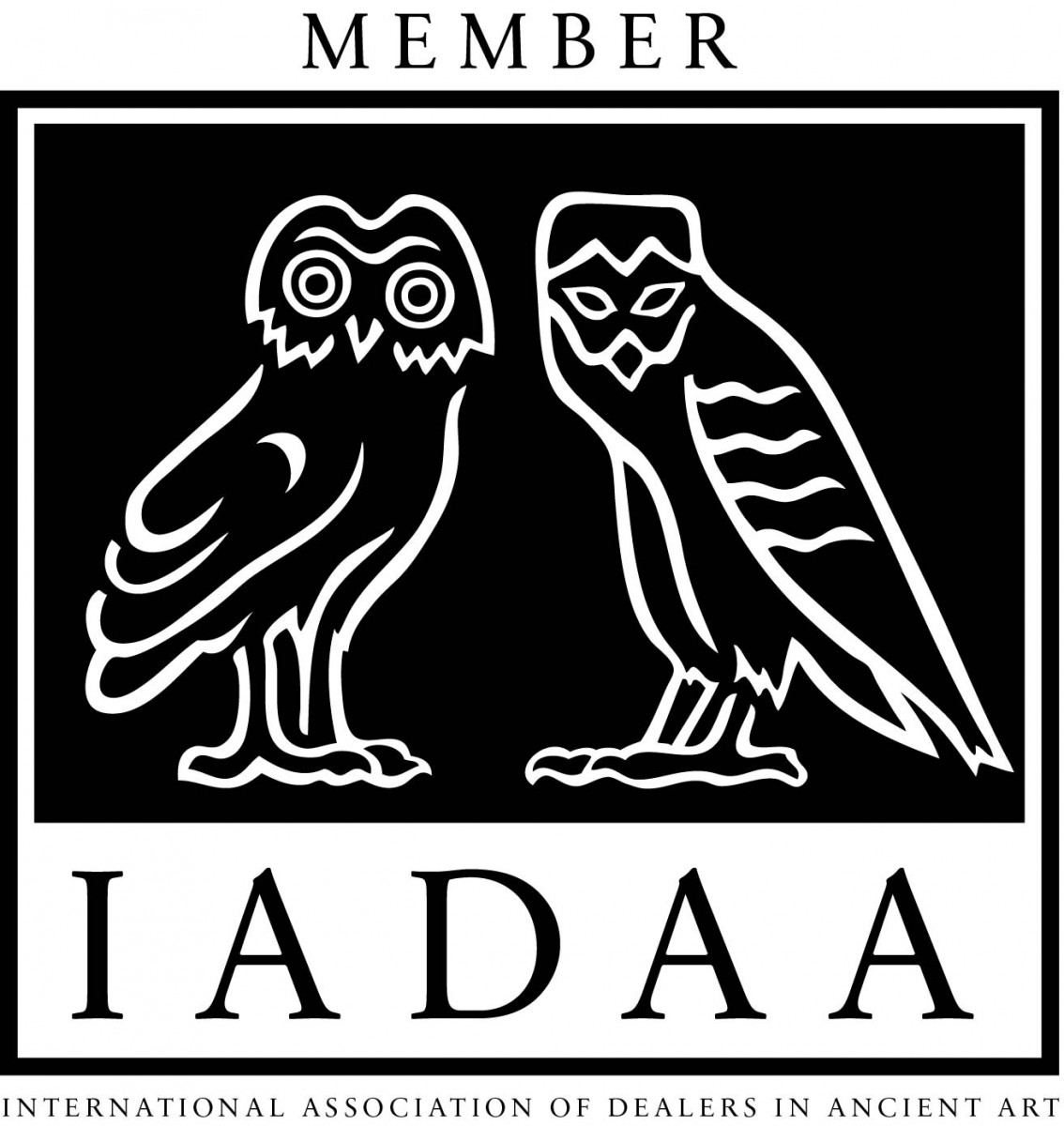
|
|
|
|
